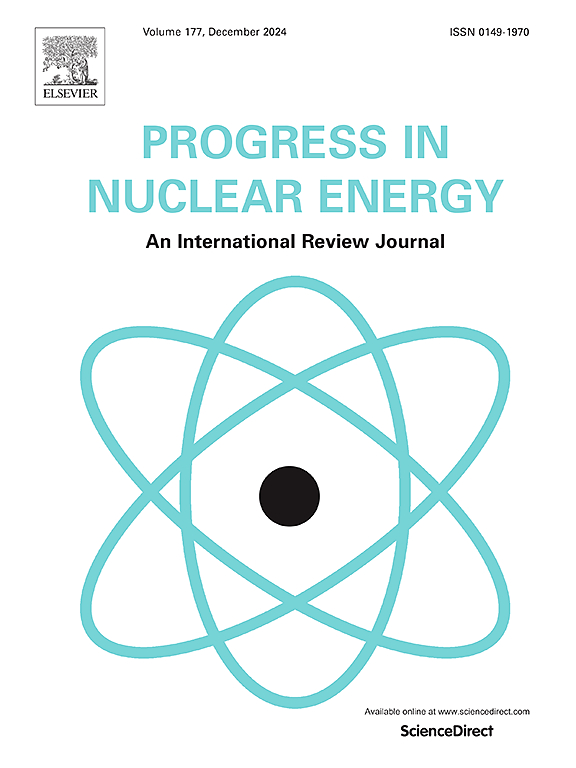T91与锆合金-4复合坯料感应加热制造双包层管:模拟与实验验证
IF 3.3
3区 工程技术
Q1 NUCLEAR SCIENCE & TECHNOLOGY
引用次数: 0
摘要
金属燃料因其较高的增殖比而成为未来快中子增殖反应堆的首选燃料。采用T91钢外壳和Zr内衬的机械键合双包层管是金属燃料的潜在选择。但与机械焊管相比,冶金焊管具有更优越的性能。采用共挤压工艺可制备T91与Zr/Zircaloy-4 (Zr-4)的共轴管。两种合金变形行为的显著差异要求在共挤压复合坯料的厚度上有温度梯度。只有通过感应加热才能实现对钢坯横截面温度梯度的精细控制。研究了外包T91、内包Zr-4双包方坯的感应预热过程。采用二维轴对称模型,考虑线圈频率、电流、节距和直径等关键参数,进行了模拟研究,以减小坯料中T91和Zr-4界面的温度变化。使用优化线圈频率和电流的模拟将界面的温度变化降低到22°C。随后的模拟采用可变线圈间距和直径将界面温度变化减小到小于±3°C,忽略轴向端。T91的平均温度为967.4℃,Zr-4的平均温度为850.3℃。对T91和Zr-4共轴管进行了实验,验证了仿真模型的正确性。本文章由计算机程序翻译,如有差异,请以英文原文为准。
Induction heating of composite billet of T91 and Zircaloy-4 for manufacturing of double clad tube: Simulation and experimental validation
Metallic fuel is the preferred choice for future Fast Breeder Reactors due to higher breeding ratio. A mechanical bonded double clad tube with a T91 steel outer shell and Zr inner liner is a potential choice for metallic fuel. However, the metallurgical bonded clad tube will have superior properties against the mechanical bonded tube. The metallurgically bonded co-axial tube of T91 and Zr/Zircaloy-4 (Zr-4) can be manufactured by the co-extrusion route. The significant difference in deformation behavior of the two alloys demands a temperature gradient over the thickness of the composite billet for co-extrusion. The fine control of temperature gradient across the cross section of the billet can be achieved only by induction heating. The present study focuses on simulating the induction preheating process of a double-clad billet of outer T91 and inner Zr-4. A 2-D axisymmetric model was considered and simulation studies with several key parameters such as coil frequency, current, pitch, and diameter were carried out with an aim to reduce temperature variation at the interface of T91 and Zr-4 in the billet. Simulations using optimised coil frequency and current reduced the temperature variation at the interface to as low as 22 °C. Subsequent simulations with variable coil pitch and diameter reduced the temperature variation to less than ±3 °C at the interface ignoring axial ends. The mean temperature across the T91 was 967.4 °C and across Zr-4 was 850.3 °C. Experiments were conducted for the co-axial tube of T91 and Zr-4 to validate the simulation model.
求助全文
通过发布文献求助,成功后即可免费获取论文全文。
去求助
来源期刊

Progress in Nuclear Energy
工程技术-核科学技术
CiteScore
5.30
自引率
14.80%
发文量
331
审稿时长
3.5 months
期刊介绍:
Progress in Nuclear Energy is an international review journal covering all aspects of nuclear science and engineering. In keeping with the maturity of nuclear power, articles on safety, siting and environmental problems are encouraged, as are those associated with economics and fuel management. However, basic physics and engineering will remain an important aspect of the editorial policy. Articles published are either of a review nature or present new material in more depth. They are aimed at researchers and technically-oriented managers working in the nuclear energy field.
Please note the following:
1) PNE seeks high quality research papers which are medium to long in length. Short research papers should be submitted to the journal Annals in Nuclear Energy.
2) PNE reserves the right to reject papers which are based solely on routine application of computer codes used to produce reactor designs or explain existing reactor phenomena. Such papers, although worthy, are best left as laboratory reports whereas Progress in Nuclear Energy seeks papers of originality, which are archival in nature, in the fields of mathematical and experimental nuclear technology, including fission, fusion (blanket physics, radiation damage), safety, materials aspects, economics, etc.
3) Review papers, which may occasionally be invited, are particularly sought by the journal in these fields.
 求助内容:
求助内容: 应助结果提醒方式:
应助结果提醒方式:


